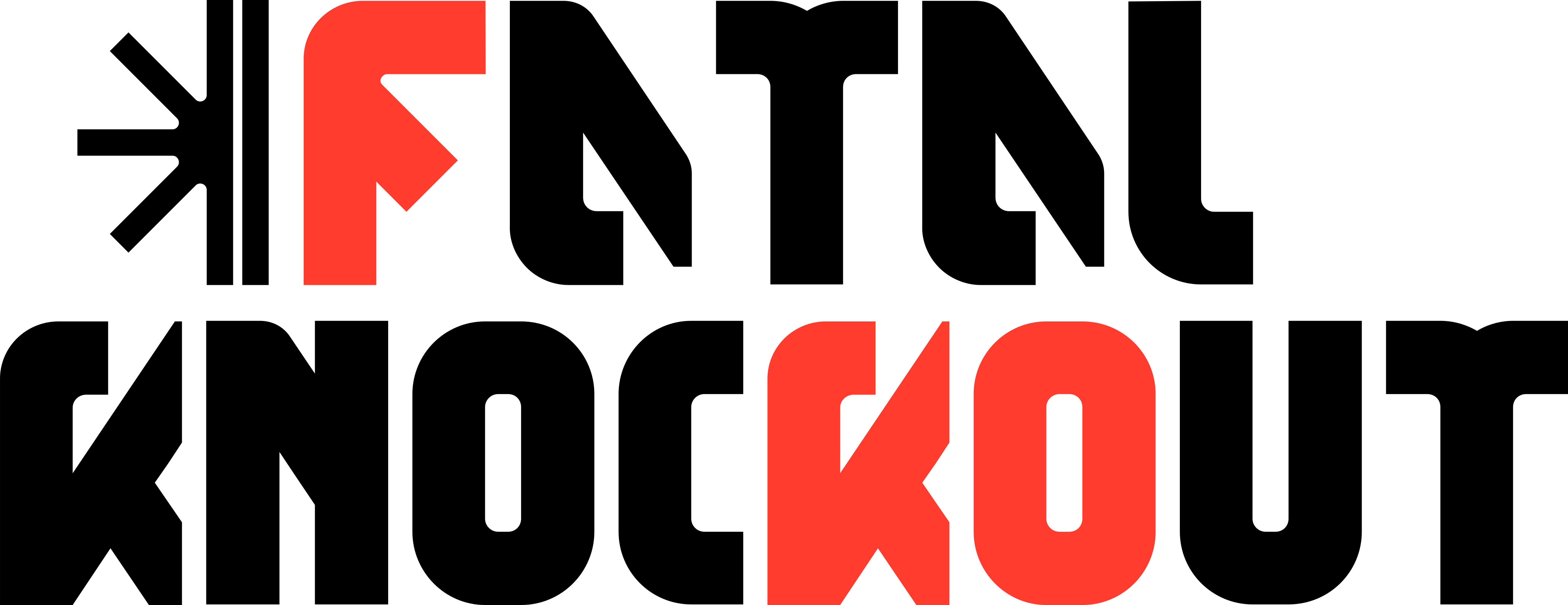
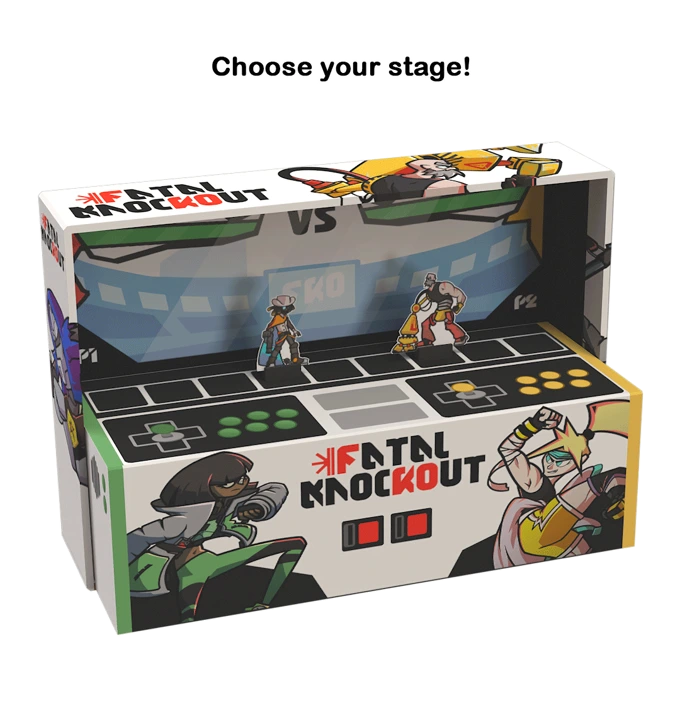
Project Details
Project Type: Commercial Board Game
Genre: Fighting, Competitive
My Roles: Co-Game Designer, QA, Voice Actor.
Skills Developed: Capturing the essence of a traditional 2D fighting game in a board game format, Rigorous Playtesting and design iteration in accordance to it, Character balance in response to Playtests, Designing within the restrictions of a physical product (E.g. realistic amount of tokens and game resources to be printed), Using Tabletop Simulator for near-instant paper prototyping, Creating a variety of characters based around their archetype in the roster and their respective “fantasy”, Building hype for a Kickstarter project through tournament shoutcasting / interviews / trailers / conventions.
Game Description
Fatal Knockout is a fighting game themed competitive board game created by me and Niall Crabtree from Crab Studios. It is a game that intends to capture the essence of traditional 2D fighting games such as Street Fighter, Guilty Gear, Samurai Shodown, and Blazblue in board game fashion.
In Fatal Knockout, you play cards that allow fighters to move, change orientation, and attack on the board. On top of that, each fighter has one-of-a-kind abilities, playstyles, and powerful “KO” cards that are triggered by playing cards and gaining meter. Knock out your opponent before they knock you out!
The base game comes with six fighters, and the “oddities” expansion comes with four more fighters (a total of 10 fighters in the base roster!), with completely unique decks that reflect their archetype and playstyle.
Fatal Knockout can be played solo against a bot, with two players, or in a tournament format where players advance through brackets with the aim of being crowned the winner!
Have a gander at our successful Kickstarter page!:
https://www.kickstarter.com/projects/crabstudios/fatal-knockout
Adapting a Fighting Game into a Board Game
As an avid fighting game player and designer, I was put on the project to be in charge of controlling the vision and adaptation of the core systems so it would feel natural to someone who came from the video games that inspired it.
I’d like to use this next portion to provide an insight into my main design contributions that helped cement the 2D fighter “feel”:
1. The Shield:
In the early prototypes of Fatal Knockout, the Shield was there as it is today to give the player a decision to simply “block” incoming damage.. However, the game was all about movement and player orientation. To fix the “one-note” feel of the Shield I was inspired by how in most fighting games you will hold a direction to block incoming damage, usually having to choose correctly or be punished! This is one of core pillars of fighting games and so I came up with a solution that felt intuitive and deepened the gameplay a lot.
When you block, you choose a fixed direction (left or right).
This introduced a lot of depth to blocking. It didn’t just solve all your problems for you anymore. You have to anticipate what angle they might be planning to attack you from and act accordingly.
2. The Corner:
In every fighting game, it is common knowledge that “being in the corner” is terrifying indeed. There’s many reasons for this; it reduces your defensive options, it unlocks high damage combos for the opponent, and you are trapped.
Fatal Knockout has corners, though they aren’t innately scary since you can move through people in this game. Therefore, there was need of some mechanical changes to help it feel true to its inspirations.
Knockback is a common tool in the game, a non-lethal attack which can reposition an enemy. I implemented and tested a ruling where any amount of Knockback against the corner specifically causes a person to take 1 damage. Certain grappler-style characters then had a much scarier presence as they could do extreme damage given the right circumstances. Going forward, the slower more grappler-type characters in the game are now designed around this advantage.
3. The Pocket:
Burn Tokens allow you to “mulligan” your current hand at any point as long as you have one to spend. The issue with the old Burn system is that you simply used Burn Tokens to dump unwanted cards into the discard pile which would only be interacted with again after all your cards are gone and they are reshuffled. This system felt very undercooked mostly because the only decision being made was “Do I want these cards? No? Dump them!”
My solution to this was an extra pile called the “Pocket”, which sat alongside the Discard pile. When you use a Burn token, it instead places those cards into the Pocket. The Pocket is special because you always have the choice to draw from both the deck and/or Pocket at the start of your turns. Also, each time you use a Burn token, it replaces the Pocket and moves your previously pocketed cards into the Discard.
This now allows you to strategize your turns by giving you many options; dumping your hand in an emergency, setting up for the next turn, discarding the pocket for specific setups, etc.
4. The Meter Track and KO Cards:
The Meter Track and KO Cards were a new mechanic implemented later in the prototyping phase which ended up cementing the game’s overall pacing. Initially, matches felt very fleeting when they ended and lacked any build-up or moments of satisfying impact during them.
The Meter Track is a system that builds up as you use certain cards that progress it, usually more utility focused cards that promote planning and patience – encouraging a player to take a step back and prep rather than always go in and attack face. Steps along the Meter Track award you with different bonuses. Each Meter Track is unique to that character, thus opened up a lot of exciting design space to tinker directly with character gameplans, pacing, and win conditions.
KO Cards are the ultimate payoff at the end of the Meter Track. You are awarded with your unique KO Card at the end, which goes immediately to the top of your deck. This gives you a good excuse to have that big “moment of impact” that can end a round when used correctly.
5. The Planning Phase changes:
Originally, in the Planning Phase each player would play their cards face-up, which resulted in an almost turn-based “read and react” style of play which had no reason to end early and didn’t have much gameplay to it other than reacting to the strongest cards the other player had.
I implemented a change later into the prototyping phase in accordance to general playtesting and how the game felt at the time. The change was to have every card apart from each player’s first card be hidden face-down. Combining this with the long-established rule that a player can play as many cards as they want in the Planning Phase, this set the whole game itself in motion. Suddenly, there were mindgames around what information you wanted to show the other player. This caused things such as bad hands to be viable if you bluff to save on Burn tokens, tricking the opponent into thinking your playing a slow turn with a slow card – then hide a bunch of fast initiative cards afterwards, and many many more.
This was without a doubt, the simplest and most impactful change to Fatal Knockout’s design in my opinion.
Base Game (6 playable fighters)
Oddities Expansion (4 playable fighters)

Media & Reviews
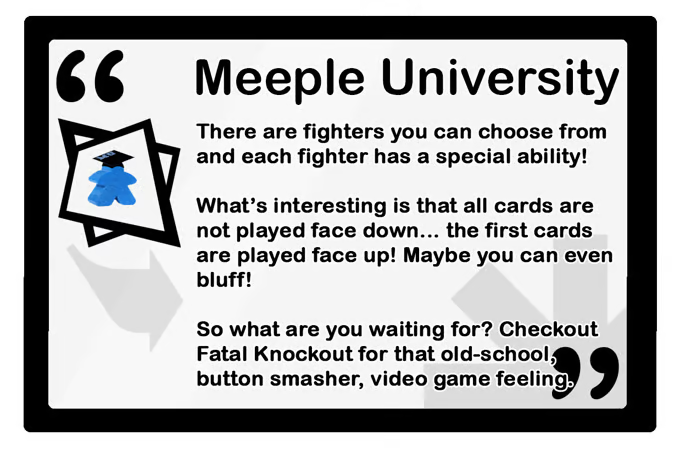
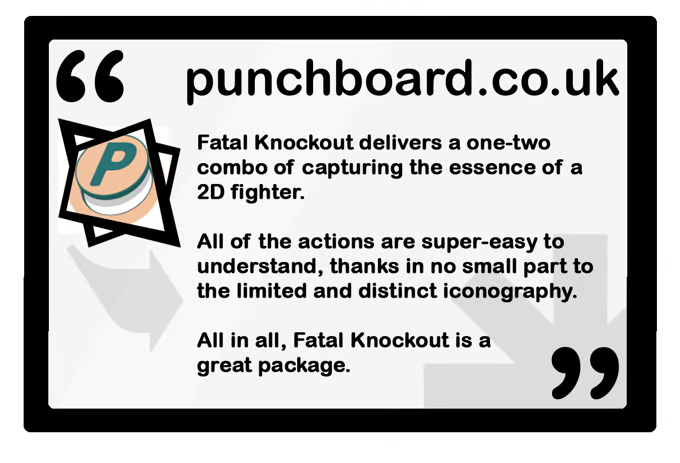
Kickstarter Trailer
Tournament Highlights
